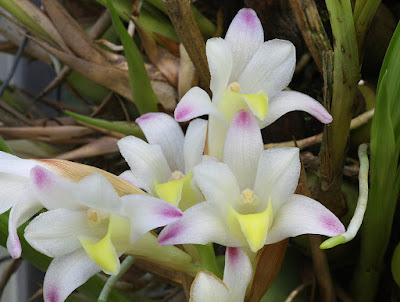Coelia bella is native to Mexico, Guatemala, Honduras, Belize, and Costa Rica. It grows directly on land (rarely epiphytic) at an altitude of 500 to 1500 meters above sea level...
Coelia bella also called as The Beautiful Coelia, Bifrenaria bella, Bothriochilus bellus, is a species of the genus Coelia. This species was described by Heinrich Gustav Reichenbach in 1861.
IDENTIFY COELIA BELLA ORCHID PLANT
Coelia bella is native to Mexico, Guatemala, Honduras, Belize, and Costa Rica. It grows directly on land (rarely epiphytic) at an altitude of 500 to 1500 meters above sea level.
It is a medium to large sized, warm to cool growing terrestrial and occasional epiphytic species with clustered, ellipsoid to ovoid, olive green, about 5 cm long pseudobulbs carrying up to 5 apical, narrowly lanceolate, acuminate, plicate, glossy green, up to 60 cm long leaves.
The Beautiful Coelia blooms in the summer on an erect, basal, 15 cm long, bracteate, racemose inflorescence with up to 6 scented flowers that arise from the side of a new pseudobulb. The flowers are basically white, with purple tips on the tepals and yellow lip, measuring 3 to 7 cm in diameter, very pleasantly smell of marzipan.
COELIA BELLA ORCHID PLANT CARE AND CULTURE
Cultural information should only be used as a guide, and should be to be adapted to suit you. Your physical location; where you grow your plants, how much time you have to devote to their care, and many other factors, will need to be taken into account. Only then can you decide on the cultural methods that best suit you and your plants.
Light:
Coelia bella is grow in bright scattered light. The ideal location is considered to be the south-east or east-orientated windows, but if there are not any, then you can use the western or southern windows. If the western or southern windows were chosen for the location of the plant, then during the period from May to early September, the orchid should be protected from the influence of too bright day and evening sun - put behind a curtain (for example, on a table near a window) or into the shade of other plants.
Temperature:
This type of orchid belongs to a moderate temperature regime, and it is recommended to keep the orchids under the following conditions throughout the year: Summer temperature is not higher than 25 ° C during the day and around 18 ° C at night; Winter temperature at 12-16 ° C. To successfully grow at home, it is necessary that the night temperature of the content is always 6 ° C lower than the daytime temperature.
Humidity:
The Beautiful Coelia needs the humidity level of 50 to 70%. Too dry air adversely affects the development of the plant and its growth is inhibited, and the leaves begin to turn yellow and dry.
Substrate, growing media and repotting:
Coelia bella is grow only in pots in a sufficiently moisture-intensive substrate, which is recommended to use a mixture of bark of coniferous trees, peat (up to 60%), charcoal and sphagnum moss.
Repotting is recommended only in cases of severe salinization or compaction of the substrate, its critically low or high pH, or if the plant grows very large and the pot becomes too small. The best time for transplant is the period immediately after flowering and until the moment when new sprouts begin to grow their own roots.
Watering:
During the growing season (the development of new shoots), this plant needs frequent and abundant watering. When watering orchids in pots, it is necessary to remember that excess water during watering should flow freely out of the pot, as the stagnation of water both inside the pot and in its pallet can very quickly lead to rotting of the roots and the lower part of the plant. The substrate between watering should dry well, but do not stay more than two days in a completely dry state.
Fertilizer:
During the new growth period, this type of orchid is fertilized weekly in the usual concentration of fertilizer indicated on the package. In addition to the usual root top dressing, it is also recommended to produce a foliar dressing, when a very much diluted fertilizer is sprayed on the outer part of the plant. It is best to feed the orchid, alternating both these methods.
Rest period:
If the development of Coelia bella occurs according to the natural schedule, then the maturation of new pseudobulbs occurs at the beginning of September, i.e. when new shoots reach the size of old ones and begin to turn into pseudobulbs. From this point on, this orchids contain much drier and colder than usual, and do not fertilize. The ideal temperature is 15-16 ° C in the daytime and about 12 ° C at night. Watering the orchids should be replaced with a light spray of the substrate and this procedure should be performed only when the substrate not only completely dries, but even at least 5-6 days it will be completely dry. With the appearance of peduncles, the rest period ends: the total temperature of the orchid content rises to 18 ° C, and watering is carried out as the substrate dries.

















COMMENTS